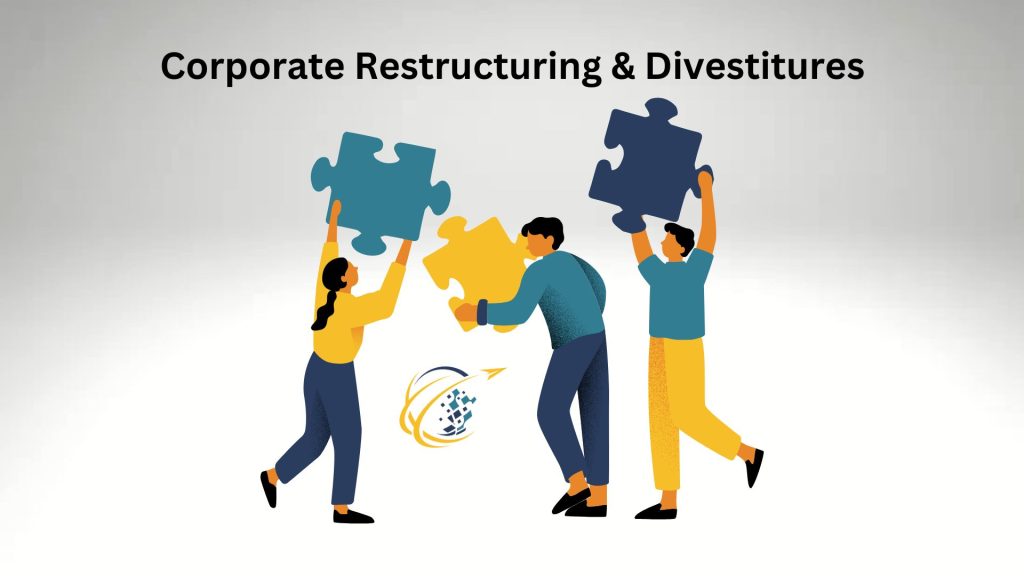
Corporate restructuring and divestitures have become vital tools for companies looking to remain competitive and improve profitability. These processes often involve a fundamental reorganization of a company’s structure, operations, or asset portfolio. Corporate restructuring and divestitures allow businesses to optimize their resources, streamline operations, and focus on core competencies. By realigning their strategies, companies can enhance shareholder value and position themselves for long-term growth.
What Is Corporate Restructuring?
Corporate restructuring refers to significant changes a company makes to its organizational structure, operations, or financial arrangements. The primary goal is to increase efficiency and improve the overall performance of the business. Corporate restructuring often includes mergers, acquisitions, consolidations, spin-offs, or internal reorganizations. This strategy is frequently employed when companies face financial distress, declining profitability, or when they need to adapt to new market conditions.
In many cases, corporate restructuring is driven by the need to reduce costs, improve cash flow, or eliminate redundancies. For example, a company might restructure by merging divisions that serve similar functions, or it might outsource certain operations to lower-cost providers. The ultimate objective is to improve operational efficiency, making the company more agile and better positioned to compete in its industry.
Types of Corporate Restructuring
Corporate restructuring comes in various forms, depending on the company’s needs and objectives. Financial restructuring, for instance, involves reorganizing a company’s capital structure by reducing debt or negotiating new terms with creditors. Operational restructuring, on the other hand, focuses on optimizing day-to-day business operations by consolidating divisions or adopting new technologies.
In recent years, regulatory changes and technological advancements have made restructuring a common occurrence across various sectors. According to a 2022 report by McKinsey, companies that effectively engage in corporate restructuring are more likely to see improvements in profitability and market share within two to three years of implementation.
The Role of Divestitures in Corporate Restructuring
Divestitures are a key element of corporate restructuring, especially when a company seeks to streamline its operations or focus on its core business. A divestiture involves selling off a business unit, division, or asset that is no longer aligned with the company’s long-term strategy. By shedding non-core assets, companies can focus their resources on areas that offer the highest potential for growth and profitability.
In many cases, companies divest underperforming units to reduce costs or improve liquidity. However, divestitures are not always driven by poor performance. Sometimes, a company may choose to sell a high-performing business unit that no longer fits within its broader strategic vision. For example, General Electric divested its financial services arm, GE Capital, in 2015 to refocus on its industrial operations.
Divestitures can also create value for shareholders. Research shows that companies that engage in well-planned divestitures often see their stock prices rise as investors reward their focus on core strengths. According to a PwC report, 70% of companies that completed a divestiture in the last five years reported improvements in profitability within 18 months.
When Should a Company Consider Divestitures?
Divestitures are typically undertaken when a company realizes that certain business units or assets no longer align with its strategic goals. These decisions are often influenced by changes in market conditions, shifts in consumer behavior, or technological disruption. For example, companies in the energy sector have increasingly divested from fossil fuel assets to focus on renewable energy in response to the global push for sustainability.
Moreover, divestitures may be part of a broader strategy to unlock shareholder value. In industries such as healthcare and technology, companies often divest non-core units to generate capital for investment in innovation and research. Divesting non-essential assets can also help companies reduce debt and improve their balance sheets, giving them the flexibility to pursue new growth opportunities.
However, companies must carefully plan and execute divestitures. Poorly managed divestitures can disrupt operations and result in the loss of valuable talent or intellectual property. Therefore, companies must conduct thorough analyses to ensure that divested assets are non-critical to the company’s future success.
Successful Examples of Corporate Restructuring and Divestitures
Many high-profile companies have used corporate restructuring and divestitures to improve performance and strengthen their market position. For example, IBM restructured in the 1990s, shifting from hardware manufacturing to software and IT services. During this transformation, IBM sold its personal computer division to Lenovo in 2005, focusing on higher-margin services. Similarly, Johnson & Johnson restructured in 2021, separating its consumer health business from its pharmaceutical and medical devices units. This move streamlined operations and encouraged innovation in healthcare. Procter & Gamble restructured in the early 2010s, divesting over 100 brands to focus on its core products, such as Tide and Pampers. This resulted in a more agile company with better financial performance and market share.
The Challenges of Corporate Restructuring and Divestitures
While corporate restructuring and divestitures offer significant benefits, they are not without challenges. One major challenge is managing the human element. Restructuring often leads to layoffs, which can impact employee morale and productivity. Companies need to communicate transparently with their workforce throughout the restructuring process to minimize disruption and maintain employee engagement.
Additionally, restructuring can be expensive and time-consuming. Legal, financial, and operational complexities can arise, particularly when divesting large business units or merging divisions. Companies must ensure they have the right expertise and resources in place to manage these complexities effectively.
Another challenge is maintaining business continuity during the restructuring process. Companies must prevent any adverse effects on day-to-day operations while they implement structural changes. This requires careful planning and strong leadership to navigate the transition smoothly.
The Long-Term Benefits
Despite the challenges, corporate restructuring and divestitures are powerful tools for improving business performance and ensuring long-term success. By restructuring, companies can streamline operations, reduce costs, and focus on areas with the highest growth potential. Divestitures, when executed correctly, can unlock significant value for shareholders and position the company for future growth.
To succeed, companies must approach restructuring and divestitures with a clear strategy, careful planning, and a focus on long-term goals. With the right approach, corporate restructuring can be a catalyst for innovation, efficiency, and sustained profitability in a rapidly changing business environment.


